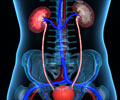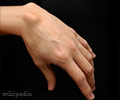Boffins have made a new device, Novo-TTF (Tumor-Treating Fields), for treating brain cancer patients using electrical field therapy, which could more than double the survival rates
Boffins have made a new device, Novo-TTF (Tumor-Treating Fields), for treating brain cancer patients using electrical field therapy, which could more than double the survival rates for people with one of the most common types of brain tumour.
The device uses low intensity electrical fields delivered via insulated electrodes on the scalp, to disrupt tumour growth by interfering with cell division of cancerous cells which causes the cells to stop proliferating and die off instead of dividing and growing.The device was developed by a team of researchers led by Professor Yoram Palti at the Technion-Israel Institute of Technology.
The fields disrupt the movement of a cell's inner building blocks during division, so that it dies off before proliferating. Cancer cells typically divide at a much faster rate than most normal cells, making them a prime target for TTF.
Treatments such as chemotherapy and radiation also target rapidly dividing cells, but they can cause severe side effects by damaging the intestinal lining and bone marrow, where normal cells divide quickly.
"One of the advantages of TTF therapy is that only a small fraction of its electrical fields can penetrate into these sensitive tissues," Palti said.
Researchers conducted a pilot study of 10 patients with recurrent glioblastoma, a rapidly growing type of brain tumour, to test the effectiveness of the treatment.
Advertisement
The study found that the therapy significantly slowed the growth of tumours as well as increased survival rates. Previously, patients with advanced glioblastomas could expect to live on average six months or less. With the therapy, the average reprieve was more than a year, and three of patients in the small trial were still alive, more than two years after their therapy began.
Advertisement
The researchers have tested the treatment successfully on 15 types of cancer cells, including human breast, lung and skin cancer cells so far and are hoping that the therapy might be useful in treating a variety of cancers.
"Our basic assumption is that the treatment will be effective for most types of solid tumours," Palti said.
The findings of the study were published in the June issue of the Proceedings of the National Academy of Sciences USA.
Source-ANI
LIN/M








